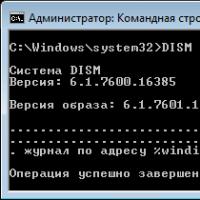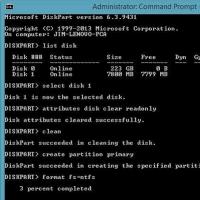Windows Defender Updates 7. Windows Defender Security Center errors and how to fix them
You went to Windows 10 Update, and it says:
Having trouble installing some updates...
Definition Update for Windows Defender - KB2267602 (Definition 1.215.422.0) - Error 0x80070643
Error codes can be different: 0x80200056, 0x80070002, 0x80070005 and othersIf you press “update” again, it does not write anything about the Defender, but simply writes “Device updated”. But if after a couple of days you go to the update center, then there will again appear an inscription about the error updating definitions.
If you go into the Defender itself, then the update status says "Connection error". When you try to update, the window "Failed to update virus and spyware definitions. Error code: 0x80070002".
I faced this problem in Windows 10, but for previous versions the solution is the same.
Solution 1 (Try it first)
Idea: During the update, Defender tries to delete the temporary folder, but it does not have enough rights to do so. Solution: delete the contents of temporary folders.For this:
- Open command prompt as administrator (how to do it?)
- Download the fix.cmd script and run it through the command line. Or you can copy one command at a time, paste it into the command line and run it.
- After that, go to Update Center → Check for Updates. Then open Windows Defender and update the definitions through it.
Solution 2 (if the previous one doesn't work)
The idea is the same: Defender cannot access his own folder. So we need to delete this folder, and the next time you start the Defender, it will create it again, already with the necessary access rights.
So:
- To delete the Defender folder, you need to disable it completely:
- Turn off the Defender in the settings (all switches to Off).
- Download NoDefender, run, follow the instructions.
- Download and install Winaero Tweaker (portable or regular installation - it doesn't matter). We start, we type in the search for defender or in the left menu we look for the section Windows Apps → Disable Windows Defender from the bottom. Click "Disable Windows Defender".
- Delete the C:\ProgramData\Microsoft\Windows Defender folder. Who is afraid to delete - you can simply rename it. It may be worth restarting your computer after this step.
- Turn on Defender again. First in those two programs, then in the settings. Also, through Winaero Tweaker, you can return the Defender icon in the tray (if it is gone).
- It is probably worth clearing all temporary folders again (as written in Solution 1).
- Now update the Defender - everything should work out.
Conclusion
Windows also has an update troubleshooter. Unfortunately, it does not fix the problem with the Defender. But just in case, run it:- In Start, type "Windows Update Troubleshooting" → Run → Click Next everywhere.
- Open the Update Center and click Update.
Request
I am writing this post a few weeks after the fix itself. Some of the details are confused. For example, I don't remember what to run first: NoDefender or Winaero Tweaker. I also don’t remember at what point you need to restart the computer - or maybe you can do without reboots at all?If you tried to solve the problem and you succeeded or not, then write in the comments about it. Maybe in some points I had to do something that I did not specify?
Hello dear friends. Everyone, probably, at least once faced with " Windows Defender". Today I will tell you what this "defender" is, what it is for, how it works and how to enable / disable it.
It's no secret that at present there are many different spyware and viruses that are aimed at controlling a computer from a distance. With the help of such programs, attackers can find out your passwords, personal resources, and also steal important information. After that, they can introduce code into the computer that will finally destroy your operating system.
To prevent this from happening, for the security of your computer, it is recommended to install antiviruses, activate the Windows firewall, which reduces the risk of computer infection. On the network, of course, there is also for security, but it is not a fact that it can be real, that is, it will not harm your computer.
Windows Defender - what is it?
In short and clear, this "defender" ensures the safety of the computer from the above fraudulent programs. Unfortunately, there are programs that the antivirus cannot detect. Therefore, this "defender" penetrates the program code of the malicious program. When Windows Defender finds such a program, it removes it.
From the moment you install and start Windows, Windows Defender will run in the background.
How to open Windows Defender?
To open Windows Defender, follow these steps:
"Start" → in the search bar enter the word " defender ».

What features does the program have?
If you have already entered the program, then in the top tab you can see a certain program control menu, which will be used to search for malicious programs, as well as other settings for managing the search and the program as a whole. You can set the time and date of scheduled computer scans.
If you select the menu " Check Options”, then the program will offer you three options:
1. Quick check
. This is the easiest and fastest option. It is installed on the computer as standard, by default. If it is enabled, system files will be checked for the presence of virus files in them.
2. Full check
. In this case, all files on the hard drive are scanned, as well as RAM. Scanning time will depend on how full your hard drive is with files.
3. Custom scan
. This item speaks for itself. The program scans areas that you choose.

As you can see, Windows Defender is based on antivirus programs. It also has various repositories that store remote programs and files.
For more adequate work of the program, it is necessary to update it periodically.
Also, in this program there is a so-called " Magazine". It lists all actions performed by the program and actions applied to other, dangerous programs.

If you click on the link " Allowed objects”, a list will appear that will indicate programs that have been allowed by the user and are not considered malicious, and the link “ Quarantine» has a list of potentially malicious programs.
Tab « Options» allows you to manage computer scans.

How to enable and disable Windows Defender 7?
We have already figured out how to enter the program.
What to do if Windows Defender won't start? To do this, go to the "Start" menu and in the search bar enter the word " Services ».

We find " Windows Defender". We click on it. In the menu that appears, click " Run».

How to disable Windows Defender?
If your computer has Microsoft Security Essentials, Windows Defender will turn itself off.

Plus, if you click on the link " click here...", you get the following:

If you want to start this service manually, then you will not succeed either.

As you understand, Microsoft Security Essentials itself completely disables Windows Defender. By the way, it is possible that some antiviruses can do the same.
How do I update Windows Defender?
There are two ways to update the program:
1. Through the "Windows Update Center". In this case, the program will be updated automatically. But, for some users, automatic updates may be disabled, so the second option is needed.
2. The second option is quite simple, it starts from the moment you open the program. When you open it, you will see an inscription where you will be prompted to update the program for further work.

So, there is a button Check for updates". You need to press it. After you click it, the program will start connecting to Windows Update. The time it takes to search for and download updates directly depends on the speed of the Internet.

When the program finds updates, they will be installed.

After all the steps to update the program will be ready to work.
Hello admin! After I upgraded Windows 8.1 to Windows 10 on my laptop, the top ten began to be actively updated, and after each shutdown of the laptop, the message “Working with updates. Completed 100%. Do not turn off the computer "and the laptop does not turn off for a long time, I'm tired of it and I. Everything would be fine, but I use Windows Defender as an antivirus program, and its antivirus databases are updated via Windows Update, which I disabled, which means that the antivirus databases of the antivirus built into Win 10 do not receive updates. How can I manually update Windows Defender? Can I separately download the Windows Defender update files for Windows 7, Windows 8.1, and Windows 10 operating systems?
Hello friends! We all know that the free antivirus built into Windows 10 protects our operating system from various malware and receives virus signature updates every day through Windows Update.
If you have disabled updates in Windows 10, this means that the Windows Defender antivirus built into the operating system will also not be updated. Therefore, it is of great importance to keep Windows Update enabled so that Windows Defender receives updates in a timely manner.
If for some reason you have disabled Windows updates, then you can update Windows Defender manually (offline), in today's article I will show you how to do this.
In Windows Settings, select "Update and Security"
Then "Windows Defender" and look at the version of the subsystem, as well as the definitions of the antivirus program and the definition of the antispyware program. After a manual update, the versions should change.

Left-click on the "Search Windows" button

And we type "Windows Defender", then click on the appeared application "Windows Defender",

The Windows Defender Antivirus window appears. We see that the definitions of viruses and spyware are very old.
Click on the "Update" button.

Click on the button " Definition update».

Windows Defender antivirus databases are being updated.

Antivirus updated.

The subsystem version, as well as the definitions of the anti-virus program and the definitions of the anti-spyware program, have changed.

During the update process, you may get an error - "Failed to update virus and spyware definitions."

https://www.microsoft.com/en-us/wdsi/definitions
Microsoft anti-malware and spyware protection update.
Scrolling down to words...

Updates to protect against malware and spyware.

We select the version of the operating system installed on our computer and its bit depth. In my case, this is Windows 10-64 bit.

A 120 MB file mpam-fe.exe with virus signature updates for Windows Defender is downloaded to my computer. I am running this file as administrator.

The program does not open any window. Windows Defender is updated in a few minutes. Now in the Windows settings, select "Update and Security", then "Windows Defender" and look subsystem version, as well as anti-virus and anti-spyware definitions. After a manual update, the versions should change.
Hello, friends! While writing about Microsoft Security Essentials, I came across Windows Defender 7. I realized that I didn’t know anything about it and decided to write an article to clarify for myself why Windows Defender 7 is needed and when it is advisable to use it.

The main window of Windows Defender 7 is shown in the figure below.

If Windows Defender does not start, then you may need to manually start the service of the same name. Also, by searching in the Start menu, launch the "Services" utility

Finding a service Windows Defender and double click on it. In chapter Launch type select from the dropdown menu Automatic (delayed start) and press the button " Run»

After that, we should start Windows Defender without any problems. If the service, for some reason, could not be started, then I would check the computer for viruses with two different utilities (for example, Dr.Web Cureit and Kaspersky). Then I would check for Trojans using MBAM. Rebooted and would try to start the service. If the result is negative, then performed system file recovery. If now the result is negative, then I would think about reinstalling the operating system.
Let's hope that turning on and running Windows Defender will be easier.
How to turn off Windows Defender
Everything seems to be clear with the excluded files, folders and file types. If the defender, by mistake, reacts to a file that is known to be safe, then you can add it to the exceptions.
On the tab in detail, just like in Microsoft Security Essentials, I check the checkbox for checking USB devices so that the defender checks connected flash drives, external hard drives and other information storage devices.

In chapter Administrator you can turn off the defender completely and allow the log to be shown to all users. If there are multiple users on the computer, you can let them see what Windows Defender 7 has found.

All with settings.
Windows 7 defender update
If you want, for example, to conduct a full scan of your computer, then before that it is advisable to check for updates. You can do this by clicking on Down Arrow next to the help icon and selecting Check for updates

Magazine
In chapter Magazine you can see what the defender did with the detected objects.

Microsoft SpyNet
In the Log section, you can join the Microsoft SpyNet community. That is, if your computer is running unknown spyware and you are connected to Microsoft SpyNet, then information from your computer will be sent to Microsoft. There they will work and find the "Antidote". This "antidote" with new definitions will then be loaded into Windows Defender 7 on all computers in the world and this spyware will be rendered harmless.
You can join as ordinary participant or in the role experienced participant. In the second case, more data will be transferred from your computer and, as I understand it, the efficiency of finding the antidote will become higher.

You can also join the Microsoft SpyNet community in the "Programs" section

I chose to join as a Power Member or the Advanced Membership Program.
Before performing the check, it is advisable to update. To perform a Quick Check, just click the button. Verify. If the computer started to work unstable, then it is advisable to conduct a Full scan. You can launch it by opening the menu to the right of the Check button.

Custom scan used to scan individual folders or external devices. Click Choose to select individual drives or directories (folders) and then Check now

All settings and usage.
How to enable defender in Windows 7 through the registry
Valentina shared this method in the comments to this article. Thanks Valentina.
- We pass in the registry branch: HKEY_LOCAL_MACHINE\Software\Policies\Microsoft\Windows Defender to the DisableAntiSpyware key, and change the value (1) to (0).
- We restart the computer and rejoice, Windows Defender is working.
Conclusion
In this article, we figured out what Windows Defender 7 is. This is not a full-fledged antivirus solution, but only protection against spyware and other potentially dangerous software. That is protection from Trojans. I will use it on very old computers (for example, on my grandfather's laptop), since the defender requires less resources than a full-fledged antivirus. My grandfather only communicates on Skype and looks at photos. That is, the likelihood of infection is minimal. I would be glad if you share your opinion on the use of Windows Defender. By the way, in Windows 8, the developers abandoned Microsoft Security Essentials and transferred all its functionality to Windows Defender 8, which also comes with the operating system. I wonder what will happen in Windows 10?
Windows defender 8.1, configure and update, automatic scan task, enable/disable windows defender. Windows 8.1 is the first version of the OS to have Windows Defender (or windows defender) computer security software built in by default. Moreover, quite a few users believe that it - Windows Defender and free antivirus Microsoft Security Essentials - is quite effective against most virus or malware attacks.
And in principle they are right, Windows Defender is quite a good antivirus package that protects against both online threats and malware in general.
It is based on the award-winning and highly effective Microsoft Forefront antivirus suite for Windows Server.
If you look at the quarterly performance reports of all the major antivirus suites, you can always see some fluctuation in their rankings, depending on the threats found during the previous 6 months and the effectiveness of their elimination. So it is definitely impossible to say which one is better and which one is worse.
Therefore, there is absolutely no reason not to use Windows Defender. Even more, it is not recommended to install any software that duplicates the functionality already in Windows, as this adds layers of complexity that eventually lead to problems.
One of the main user concerns of Windows 8.1 is that Windows Defender is not easy to find. It is not on the desktop or in the taskbar. However, the apparent difficulties, open the Applications panel from the start screen or configure computer settings on the taskbar - a little attention and Windows Defender before your eyes.
In addition, a working Defender, like any other program, can be launched from there in the future.
Attention. Never think that if you have antivirus software, smartscreen, and firewall on your PC, you are protected from malware and viruses. The people who write and distribute them use all kinds of deceit, from fake websites to phone calls, relying on the inexperience and ignorance of users and convincing them to install malware directly, even bypassing UAC.
Windows Defender has a very simple interface with four tabs: home, refresh, history, and settings.
- the Home tab provides information about the current update and scans the status of the program. You can also run a quick, full, and custom scan here. A specific scan involves scanning a specific directory, such as an external hard drive.
- the Update tab provides information about the latest program update. The large "Update" button starts the process of updating it.
- The History tab allows you to view reports of any suspicious or dangerous files.
- The Options tab contains additional program settings. This is where you can exclude certain files (maybe the program considers them to be malicious, but you know for sure that they are not), join the active protection of a Microsoft service, and forward information about suspicious files to Microsoft.
Note. Real-time protection must remain enabled. If you disable it, Windows Defender will not be able to scan for new files or websites when they are opened.
As you can see, Windows Defender is configured differently than most other antivirus packages, or rather, there are almost no settings. But it doesn't matter, the essence of any antivirus software is to always provide full PC protection, and not have a thousand settings.
Although you certainly cannot do without one setting, and this is a scheduled scan. It is not always convenient to start scanning manually, and if you miss it, the defender will immediately turn into an alarming orange color. So it's better to schedule this task. To do this, open the control panel, find the "Administration" section there, in the new "Task Scheduler" window. Double clicking on a section opens the scheduler window. On the left side of the window, under the categories Microsoft - Windows, you need to find Windows Defender. Activate it and select "Windows Defender Scheduled Scan" in the central window. Double clicking on it will open the properties window. In it, go to the "Triggers" tab and create a new task. Scanning, of course, should be daily.
If you wish, if you really miss the "" item in the context menu, you can do this, although in my opinion there are enough online services.
Another nice feature of Windows Defender is that it only runs, scans, and downloads updates when the computer is idle. That is, if you are working, playing, or doing other things on your computer, Windows Defender does not load either the processor or memory, trying to update or perform a full scan.
Note. Windows Defender is updated through Windows Update, so it's extremely important not to disable this feature.
You can configure the defender in the options on the settings tab. Here you can exclude scanning of files in certain locations. For example, you want to check some viruses with different antivirus packages. Or exclude certain file types.
Note. Prior to scanning, Windows Defender can be configured to automatically create a restore point. That will undoubtedly increase fault tolerance. Since removing viruses can sometimes lead to instability in Windows. However, be aware that System Restore can also restore a virus!
Although using either of these two options is not recommended unless absolutely necessary. What is the logic here? See for yourself. By excluding scanning in a certain directory, you make it open to any threats, because the defender will no longer monitor it. Exclusion of file types is also not an option. A harmless file type today, it could become a virus tomorrow.
Much more help will be brought by the following parameter, which excludes certain processes. For example, it can be used to exclude certain programs from scanning, which is important when conflicts arise or Windows Defender detects them as malware.
It actually happens more often than you think, benign programs are identified as malware. What is called a false positive. This can be caused by the software performing the same actions on the computer as malware, such as some kind of diagnostic tool. If you have installed software that is identified as malware, but you know for sure that it is not, exclude it here.
The "Details" options offer some other features that make sense to include. For example, a full scan of plug-in USB drives (remember that malware loves to infect USB drives because it's a great way to spread them). Here you can tell Windows Defender to automatically create a restore point when removing viruses. By checking this item, which is recommended, you can restore the system if something suddenly goes wrong.
Advice. Checking Windows Defender to scan removable media and create a system restore point is a very good idea. They provide additional security and reliability.
Disable/enable Windows Defender.
If you don't want to use Windows Defender because you decide to install third party antivirus software, just disable it. This is done in the "Options" tab in the admin section. Here you can turn it on.
If you are using third party antivirus packages - disable Windows Defender. It is strongly discouraged to have two antivirus packages running at the same time, as this can lead to conflict between them.
 How to Fix Windows Update Installation Errors Using Built-in Component Repair
How to Fix Windows Update Installation Errors Using Built-in Component Repair Free programs for Windows free download
Free programs for Windows free download Proven ways to remove protection from the drive
Proven ways to remove protection from the drive how to change windows startup ringtone how to set windows ringtone
how to change windows startup ringtone how to set windows ringtone Nokia lumiya blacklist in classmates
Nokia lumiya blacklist in classmates How to get a replacement phone under warranty
How to get a replacement phone under warranty Sony Xperia Tablet S - Specifications
Sony Xperia Tablet S - Specifications